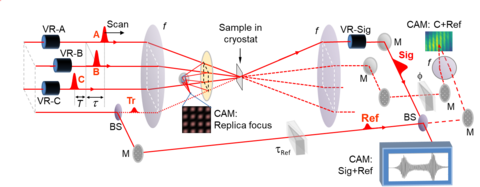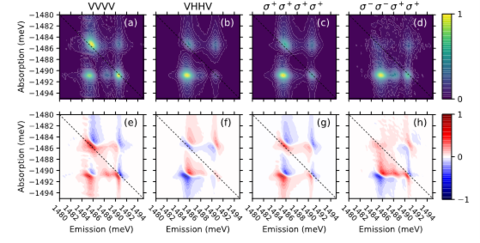Summary
Condensed matter dynamics can evolve on a subpicosecond timescale, too fast to follow using many characterization techniques. We use femtosecond optical pulses to probe ultrafast dynamics in nanometer scale materials. We are developing novel techniques for materials characterization that use symmetry-breaking nonlinear optical processes, such as all-optical current injection. We also perform multidimensional coherent spectroscopy to probe how electronic states within matter respond to light. In addition to these main research efforts, we use conventional pump-probe measurements, such as transient absorption, to characterize novel materials.
Description

Fig. 1. Diagram showing our multidimensional spectroscopy experiment. Three pulses (A, B, and C) with polarization control excite the sample from three corners of a box. Light is emitted in the fourth corner and is rotated so that it is vertically polarized. This “four wave mixing” emission is compared with a reference pulse so that amplitude and phase are measured as a function of time. The 2D spectrum is calculated from this data.
The purpose of this project is to develop and refine spectroscopic techniques based on nonlinear optics for the study of novel materials. Measurements that isolate the nonlinear response are often better able to uncover physical processes that, in the linear response, are subtle and hard to isolate. Nonlinear optics can also be sensitive to effects that are not accessible in linear spectroscopy.
Novel techniques based on symmetry-breaking nonlinear optics
By combining harmonics, it is possible to generate spin and charge currents all-optically. A long-term goal is to employ this phenomenon in novel all-optical characterization techniques. Generating electric currents naturally leads to electric fields. An electric field breaks the symmetry of the material, which can cause other nonlinear processes to become allowed. Understanding the complex interplay of effects through experiment and modeling is critical to potential applications of these phenomena.
Multidimensional Spectroscopy
In collaboration with West Virginia University, we are employing two-dimensional optical coherent spectroscopy to study nanostructured materials in the near IR wavelength range using an actively-stabilized apparatus that was originally developed at JILA. This system has been modified for efficient polarization-dependent studies using liquid crystal variable retarders to control the polarization of each excitation pulse and the outgoing emission.
Polarization control is important because it can switch on and off various quantum pathways that contribute to the response of the material, isolating certain effects. We are currently using the 2D spectroscopy system to study exciton-polariton physics in a semiconductor microcavity. An example of data from this sample is shown in Fig. 2.

Going forward, we will study novel low-dimensional materials and plan to develop a new widely wavelength tunable system that will be capable of measuring a wider variety of material systems.
Pump-probe techniques
We also employ conventional optical pump-probe experiments. Pump-probe techniques were some of the first femtosecond optical techniques to be developed and are still widely used to study the dynamic response of materials following photoexcitation. In this type of experiment, a pump pulse excites the material system and a probe pulse follows behind and samples the changing optical properties as the material responds to the pump pulse. The time resolution of the experiment is limited only by the duration of the pulses, which in our case is approximately 50 fs. This is much faster than conventional electronics can measure.

